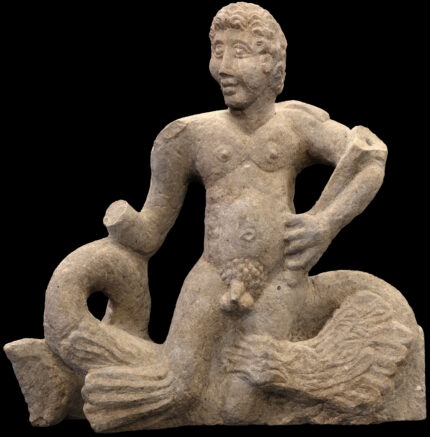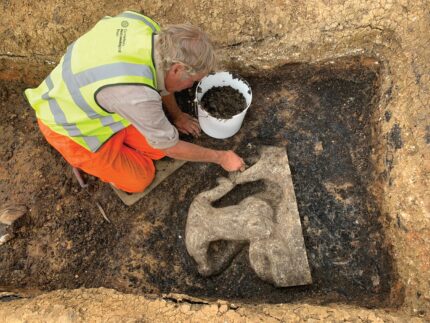 A unique statue of the Roman sea deity Triton has been discovered at the site of a new housing development near the village of Teynham in Kent. The stone figure depicts the son of Poseidon, human from the thighs up with fins below, riding a sea serpent.
A unique statue of the Roman sea deity Triton has been discovered at the site of a new housing development near the village of Teynham in Kent. The stone figure depicts the son of Poseidon, human from the thighs up with fins below, riding a sea serpent.
The head was broken off at the neck, but the two parts fit together all but seamlessly and in excellent condition. The body is approximately 28 x 8 x 21 inches and weighs 132 pounds. The head is approximately 5 x 8 x 6 inches and weighs 12 pounds.
Because of its location next to the ancient Roman road Watling Street, the site was first surveyed by archaeologists in 2017 when construction of a roundabout along the A2 road was planned. The trial trenches revealed pieces of two perpendicular chalk walls and two Roman-era cremation burials in urns.
 In 2023, a new housing development was proposed at the site. A team of archaeologists from the Canterbury Archaeological Trust (CAT) were contracted to excavate the site thoroughly. The chalk foundations found in 2017 were discovered to be sections of a 100-foot square stone walled enclosure around a square structure that was part of a large Roman mausoleum.
In 2023, a new housing development was proposed at the site. A team of archaeologists from the Canterbury Archaeological Trust (CAT) were contracted to excavate the site thoroughly. The chalk foundations found in 2017 were discovered to be sections of a 100-foot square stone walled enclosure around a square structure that was part of a large Roman mausoleum.
The date is unclear, but the fill from when it was demolished contains a Roman coin dating to ca. 320-330 A.D., so the mausoleum complex has to have been built in the early or middle Roman period. The enclosure was bounded by a large ditch that on the south end extended to the Roman road. Several graves were found within and immediately outside the enclosures.
The most spectacular find was a unique stone statue of sea god Triton, son of Poseidon/Roman Neptune (or a Triton, one of the minions of Neptune). The statue was found ritually placed within a disused clay-lined water tank, along with burnt fill material, beyond the south-east corner of the outer ditched enclosure (where the enclosure takes a double ditched form possibly to define a track heading north-east from the main Roman road). A further possible small (c.1m square) monument or statue base was found to the south of the walled inner enclosure. These associations suggest the enclosure complex and central mausoleum was a funerary site of a wealthy local family (possibly associated with a Roman villa found previously at Bax Farm further to the north) and dedicated to Roman maritime deities.
The statue has been raised and removed for conservation and further study. The in situ remains by fortunate happenstance are located in an unpaved area of the new roundabout, so the walls and enclosures will remain in place reburied for their protection.